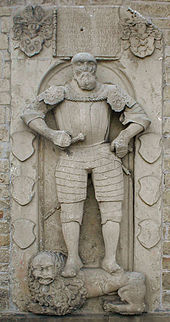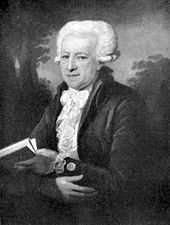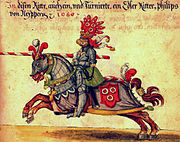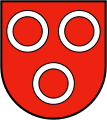Neipperg (noble family)
The lords, imperial knights, counts and imperial counts of Neipperg are an old noble family in northern Swabia . From Bertilo von Schwaigern , first attested in 1120 , the Franconian-Swabian dynasty Neipperg, named after the castle Neipperg (Niberch) near Brackenheim since 1241 , which acquired the rule of Schwaigern in the Kraichgau in 1302 . In 1726 elevated to the realm count, they arrived in 1766 in the Swabian Count Bank as HR manager for Empire state shaft and thus into the aristocracy .
In addition to Klingenberg, which was acquired in 1407, the Counts of Neipperg also owned three estates, Massenbachhausen, Adelshofen and one-half or three-eighths of Gemmingen, which were acquired in 1737 and which were part of the Kraichgau canton of the Swabian knightly district. The rulership of Neipperg fell to Württemberg and Baden in 1802 and came to the state of Baden-Württemberg via Württemberg in 1951/1962. The main line of the Counts of Neipperg lives to this day at Schwaigern Castle and operates agriculture and forestry as well as wineries in Swabia and southern France.
The Neipperg were in the service of Württemberg and Palatinate for centuries, and from 1700 they came to high offices in the administration of the Austrian monarchy in the service of the imperial house of the Habsburgs . From the main line Neipperg in Schwaigern, raised to the rank of imperial count in 1726 , the side branch of the princes of Montenuovo, who was raised to the Austrian prince status in 1864, descends.
Overview of the history of the von Neipperg family


The family first appeared in the 13th century and descended from the noble gentlemen of Schwaigern . The eponymous seat of the Neipperg was Neipperg Castle . In the 14th and 15th centuries, the Neipperg were able to expand their property through fiefs from Württemberg, Palatinate and Baden in Zabergäu and Kraichgau . In 1431 they were given the ban on blood and thus became immediately imperial . Through a clever political interplay with Württemberg and the Electoral Palatinate , the family succeeded in defending their influence and property, especially against the neighboring Württemberg, which was developing into a territorial state. In the late 15th century the family was divided into the Adelshofen line, which existed in the male line until 1708, and the Schwaigern line, which was buried in the Schwaigern town church . It carried out the Reformation in its ruled areas and had its headquarters in Klingenberg Castle from the late 16th century , before Schwaigern Castle was built as the new headquarters by Eberhard Friedrich von Neipperg (1655–1725) .
Starting with Eberhard Friedrich von Neipperg, several generations of the family were in Habsburg service, where they converted to Catholicism again and achieved high offices in the administration of the Habsburg imperial family. Eberhard Friedrich's son Wilhelm Reinhard von Neipperg (1684–1774) was raised to the rank of imperial count on February 5, 1726 . The descendants from the connection ( morganatic marriage ) of his grandson Adam Albert von Neipperg (1775-1829) with Marie-Louise of Austria , the widow of the French Emperor Napoleon I Bonaparte, formed the side branch of the Counts of Montenuovo, who in 1864 moved to the Austrian Princes were raised and existed in the male line until 1951. Most of the Neipperg embarked on military or diplomatic careers unless they were solely concerned with the administration of their possessions. The social advancement of the Neipperg is expressed in their marriages. Up until the 17th century, the spouses were predominantly Kraichgau or south-west German lower nobility families, after which there were numerous connections with spouses from the Württemberg and the House of Habsburg . The current head of the house, Karl-Eugen von Neipperg (* 1951) is married to Andrea von Habsburg, a daughter of Otto von Habsburg . Since the Second World War, the family has devoted itself in particular to viticulture on their estates in Zabergäu and the wineries in France that they acquired in the 1970s.
origin
The beginnings of the origin and relationship of the Neipperg lie in the darkness of the 11th century, but are largely secured by easily accessible sources in Swabian archives. Historians believe that the personal names Reinbot and Waramund, which are specific to Neipperg, are related to the Lords of Massenbach , Lords of Richen and Lords of Schwaigern . A Reinbot appeared in Schwaigern at the beginning of the 13th century, in 1241 a Reinbot was mentioned in Neipperg (today a district of Brackenheim ). A Waramund also appears first in Schwaigern and then in Neipperg, so that the family was a secondary line of the noble lords of Schwaigern, who then inherited the main line in the middle of the 13th century.
The fact that the lords of Böckingen and the noblemen of Fürfeld are identical in their coats of arms speaks for their affinity with the Neipperg.
In the village of Neipperg, on the Heidelberg, a southern branch of the Heuchelberg , stands Neipperg Castle , which was initially designed as a fortified, later as a representative complex and is the eponymous headquarters of the Neipperg. From the 13th century the village of Neipperg developed as a surrounding castle hamlet. The Neipperg probably owned the castle as early as the 13th century, the oldest documented fief owners are the brothers Wilhelm and Konrad von Neipperg, who were enfeoffed with the castle and surrounding goods by the diocese of Würzburg in 1304/06 . In addition to the von Neipperg family, other gentlemen had property and rights to Neipperg Castle. In 1321 an Engelhard von Weinsberg sold his share to the Counts of Wirtemberg , who enfeoffed the Lords of Gemmingen with their share around 1400 . The bearer of the name Meiser was also temporarily the owner of a part of the castle in the 14th century, which was repurchased in 1364 by Reinhard von Neipperg († 1377), who also acquired the Vogtei in Schwaigern, which had previously been awarded to the Lords of Hirschhorn .
Expansion of the rule in the 14th and 15th centuries
Reinhard's son Eberhard I. von Neipperg († 1406) was able to increase his ownership share in Neipperg Castle again, and he also took several fiefs in Schwaigern that had previously been given to various members of the family. While Reinhard was still closely tied to Württemberg as a representative in the council of Count Eberhard der Greiner from Württemberg, Eberhard I. von Neipperg had been in the service of the Electoral Palatinate since 1383 at the latest and was the representative of King Ruprecht in 1401 .
The sons and grandsons of Eberhard I von Neipperg received further fiefs and rights in the 14th and 15th centuries , including half of Bönnigheim Castle in 1391 , Klingenberg Castle and Village in 1412 , a third of the tithe in Böckingen in 1419 , and the ban on blood in Schwaigern and in 1431 1434 the place Adelshofen . The considerable increase in family property in those years was achieved primarily by Eberhard I's son Eberhard II. Eberhard II. And his brother Reinhard II. Were also able to protect the rights and claims of the family against the emerging territorial powers of Baden and Württemberg and against the growing cities. During this time Schwaigern became one of the headquarters of the family and family members belonged to the society with the donkey .
Eberhard II's son Diether von Neipperg († 1465) came under the protection of the Count Palatine in 1455 together with his uncle Reinhard II von Neipperg († 1458) with his property in Schatthausen , Baiertal , Dielheim , Adelshofen , Massenbachhausen , Schwaigern , Neipperg and Michelfeld Friedrich . Reinhard's II. Sons Wendel and Engelhard continued to develop relations with the Palatinate, while their brother Hans and two of their cousins were on the Württemberg side. Wendel († 1480) and Engelhard († 1495) received the knighthood after the Battle of Seckenheim in 1462, in which they fought alongside Count Palatine Friedrich. Engelhard was Burgvogt in Heidelberg in 1460 , Marshal of Count Palatine Friedrich in 1472 , and Vicedom in Neustadt an der Haardt in 1476 . He owned a quarter of the city of Bönnigheim , shares in Neipperg and Schwaigern as well as the entire place Adelshofen and a large number of other rights and goods. In 1478 he was involved in the re-establishment of the Society with the Donkey, which was temporarily inactive under Friedrich I of the Palatinate.
Because the Wuerttemberg area was directly adjacent and because family members of the von Neipperg family, which at that time were largely subordinate to the Electoral Palatinate, also held Württemberg fiefs, the relationship with their larger neighbors was constantly tense. The Württemberg Landgraben , built by the Württemberg people from 1473, cut through the Neipperg region.
After Engelhard von Neipperg had remained childless, his property came to two sons of his cousin Diether: Eberhard IV and Wilhelm, who thus united the entire family property, divided the inheritance in 1497 and established the Adelshofen and Schwaigern lines.
Adelshofen line
Eberhard IV von Neipperg († 1506) was inclined to Württemberg. His sons Eberhard V. († 1534) and Diether († 1541) achieved a new division of the estate with their cousin Georg Wilhelm († 1520) after his death, so that the Adelshofen line owned the eponymous town of Adelshofen and half of Schwaigern. Eberhard V. and Diether had fiefdoms from Württemberg as well as Baden, but they stayed on the Württemberg side. Diether's descendants mainly worked in Schwaigern. Georg († 1557) was a church lord in Schwaigern, later a canon in Worms. Eberhard V's son Ludwig von Neipperg († December 25, 1570) led the Reformation in his areas in 1531. His image is preserved on an ornate tombstone in Adelshofen, as is that of his granddaughter Anna Maria († December 5, 1571), who died in childhood. Ludwig's cousins Hartmann († 1571) and Hans († 1591) ran the family businesses in Schwaigern together with their cousins from the Schwaigern line. After the death of Hans's sons in 1595/1602, their property fell to Ludwig's sons in Adelshofen: Reinhard († around 1612) and Georg Wilhelm († around 1606). Although the Adelshofen line had no significant external impact and was mainly occupied with the administration of its property, Georg Wilhelm's grandson Philipp Ludwig († 1685) was elected director of the knightly canton of Kraichgau in 1659 . He and his children had close ties to the Württemberg court. With the violent death of his son Bernhard von Neipperg, the Adelshofen line died out in the male line in 1708. The manor house in Adelshofen was destroyed in 1690. Although the Schwaigerner Hauptlinie had a new moated castle built in Adelshofen in 1716 , the facility was hardly used and quickly fell into disrepair, so that nothing of it has survived today.
Schwaigern line


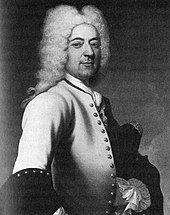
Wilhelm von Neipperg († 1498) was court master at the Margrave of Baden in 1452 , took part in the battle of Seckenheim on the Württemberg-Baden side in 1462 and was then again court master at the court of Baden and later also at the Württemberg court. His son Georg Wilhelm († 1520) was initially in the service of Count Palatine Philip in 1503 as Burgrave of Starkenburg , but after his defeat in the War of the Bavarian-Palatinate Succession in 1504 he turned back to Württemberg, was Württemberg's Obervogt in Zabergäu and confidante of Duke Ulrich . From 1514 Georg Wilhelm had the Schwaigern town church expanded significantly. The traditional burial place of the Neippergers was in the church near the castle in Schwaigern, where around 30 historical family tombs have been preserved to this day. The first impulses for the Reformation in Schwaigern probably go back to Georg Wilhelm's son Wolf († 1533) . Wolf's brother Ludwig († 1536) was burgrave in Alzey in 1532 , received the castle loan in Oppenheim in 1533 and then became court marshal of the Electoral Palatinate.
Ludwig's son Philip I († 1581) secured the continuation of the Reformation in Schwaigern in 1550 through a comparison with the Worms canon Georg († 1557) from the Adelshofen line. As there were generations of ancestors before him, Philip I was also dependent on several lords through Württemberg, Baden and Palatinate fiefdoms, against whom he was able to successfully defend himself in various disputes. In 1554 he had his seat in Klingenberg , where he had the destroyed Klingenberg Castle renovated in 1577 . Like his father, he was a Palatine burgrave in Alzey, and later also court master of the Bishop of Speyer.
The Schwaigern line branched out briefly under Philip I's sons Engelhard and Philip II. Engelhard († 1600) received Streichenberg Castle , shares in Neipperg with Stebbach and Massenbachhausen . Engelhard took his seat on Streichenberg, but the castle was given to the Electoral Palatinate before 1600. His sons, who were still underage when he died, initially continued the branch line, but died before 1649 without children.
Philip II († 1595) was in the Schwaigerner main line. He no longer entered the sovereign services, but exclusively administered his own rule, which intensified the disputes with Württemberg. His sons Ludwig Christoph († 1635) and Bernhard († 1622) were still young when he died and were under guardianship until 1615. The guardians were able to purchase goods from other family lines and branches to provide for the siblings, since the property ownership of the main line had already dwindled considerably due to the division of inheritance. Goods were acquired from the family's holdings in order to preserve their entire property and should counteract the strong fragmentation into partial property. Ludwig Christoph continued the family line, he too probably abstained from serving foreign rulers.
Ludwig Christoph's sons Bernhard Ludwig (1619–1672), Eberhard Wilhelm (1624–1672) and Friedrich Dietrich (1626–1680) were minors when their father died during the Thirty Years' War . During the war, fiefs were also confiscated and goods were otherwise forfeited. It was only after the Peace of Westphalia of 1648, which restored the ownership structure from before the war, that the family's economic foundation was secured again. In 1652 the three brothers shared the paternal inheritance. Each of the brothers founded their own family line. Bernhard Ludwig received the goods from Klingenberg, but when he died in 1672 he had only two female descendants. Eberhard Wilhelm continued the line and is therefore the progenitor of today's line, but also died in 1672, so that initially the third brother, Friedrich Dietrich, was head of the family until his own death in 1680. Due to his proximity to the Württemberg court, he acquired new fiefs and rights, but his own family line died out in 1690 with his son Johann Philipp Adam.
Eberhard Ludwig's son Eberhard Friedrich von Neipperg (1655-1725) was in the 1672 Empire baron collected was from 1689 Upper vogt from Blaubeuren , was an imperial commander against the 1693 advancing from Heidelberg to Heilbronn French, later fought against the rebellious Hungary and was in 1710 the fortress commander from Philippsburg. He was also in the Habsburg service and in 1717 became General Field Marshal . From 1707 he was director of the knightly canton Kraichgau . Under his rule, the ancestral seat of the von Neipperg family was relocated to Schwaigern Castle , which he had built, from 1702 , where he also acquired extensive real estate from 1699 to 1719.
Eberhard Friedrich's son Wilhelm Reinhard von Neipperg (1684–1774) was educator and confidante of the later Emperor Franz I and was on February 5, 1726 by Emperor Karl VI. raised to the rank of imperial count . With Wilhelm Reinhard and because of his Austrian service, the family probably became Catholic again in 1717. He became governor of Luxembourg and the county of Chiny in 1730 and won high military awards. As the imperial commissioner, he concluded the Peace of Belgrade in 1739 , for whose unfavorable conditions for Austria he was briefly sentenced to imprisonment. After his rehabilitation he continued his military career and became field marshal in 1741, knight of the Order of the Golden Fleece in 1753 , vice-president of the court in 1755, and in 1762 in command of Vienna . In 1766 he and his descendants received a seat and vote in the Swabian Count's College. Since the center of his work was in Vienna, he acquired a representative palace there near the Schottenkirche . His daughter Maria Wilhelmina became the mistress of Emperor Franz I.
Wilhelm Reinhard's son Leopold (1728–1792) was a treasurer and imperial court counselor in Vienna, he was on diplomatic missions at various European courts and from the 1760s onwards led to a prolonged financial misery of the Neipperg house through this costly activity, which in 1782 almost became a forced administration flowed. Leopold's three sons Joseph, Carl Vinzenz Hieronymus Graf von Neipperg (born November 30, 1757), Imperial Chamberlain, Grand Prior of the souvenir Order of Malta, State Prelate in Bohemia and Lord of the Grand Priory Lords of Strakonice , Warwaschau and Oberliebich as well as Adam Albert concluded a family contract in 1798, with which the repayment of debts was regulated in the course of the 19th century.
After the end of the imperial knighthood
In 1806 the county of Schwaigern was abolished and large parts of it came to Württemberg as a result of the mediatization . In 1815 the von Neipperg family was placed under the sovereignty of the Württemberg kingdom. In a Declaration of 1819 states: ". The gräflich neippergsche house retains the equality, as it has such brought so far, and the high nobility is numbered with" in a regulation from 1829 proclaims that the family home the title of Excellency TO ISSUE. The Counts of Neipperg remained patron saints of the Catholic Church. B. in Massenbachhausen , where there is also a family crypt.
Due to the military and subsequent political changes of the early 19th century, the importance of the Neipperg in the traditional areas in southwest Germany decreased. In the service of the Austro-Hungarian monarchy, however, they expanded their social position, through Erwin von Neipperg (1813–1897), an Austrian infantry general, and through Adam Albert von Neipperg (1775–1829). At the 1815 Congress of Vienna, Adam Albert represented the interests of Marie-Louise of Austria , the wife of the Emperor of the French Napoleon I Bonaparte, who owned the Grand Duchy of Parma , and in 1821 after the death of Adam Albert's first wife, Theresia Countess Pola de Treviso and the fall of Napoleon associated with him in a morganatic marriage. Adam Albert von Neipperg was also naturalized in the city of Sargans in Switzerland in 1822; his descendants have this right of citizenship to this day. Alfred von Neipperg , the eldest son from Adam Albert von Neipperg's first marriage, first married to Countess Josefina Grisoni and second to Princess Maria von Württemberg , continued the Neipperg line. His father's descendants from the connection with Marie-Louise of Austria, two daughters and the son Wilhelm Albrecht von Montenuovo (1819 or 1821 to 1895) were raised to the Austrian prince status by their grandfather Emperor Franz Joseph in 1864 as Prince Montenuovo ; the name is a translation from Neuberg into Italian. Wilhelm Albrecht von Montenuovo and his son Alfred von Montenuovo (1854–1927) remained in the service of the Austro-Hungarian monarchy until their end in 1918 at the end of the First World War. They were officers in the army and served in the imperial court service. Their branch expired in 1951 in the male line.
The tribe of followers of the main line, Adam Albert's eldest son Alfred von Neipperg (1807-1865) gave, 1831, the King of Württemberg William I nor in the style of the old feudal system, together with his brothers the village Schwaigern with accessories, Burg Neipperg, hunting grounds in Kleingartach, Bönnigheim and Erligheim as well as goods in Schwaigern and Wald near Neipperg. In 1833 he and his brothers signed a family contract on succession, which grants the entire property to the firstborn son. Both Alfred and his three younger brothers Ferdinand (1809–1843), Gustav (1811–1850) and Erwin von Neipperg (1813–1897) were in Austrian service. Erwin in particular earned high military awards and, after 1850, ran the family business for his sick brother Alfred, who had been married to Princess Marie of Württemberg since 1840. Since Alfred remained childless, Erwin and his son Reinhard (1856-1919) continued the family line. Reinhard only had a comparatively short military career, he was a member of the Reichstag from 1881 to 1890 and he was responsible for major modifications to the castle and rent office in Schwaigern around 1900.
The Counts of Neipperg in the 20th and 21st centuries
Reinhard's eldest son Eberhard (1882–1956) renounced the line of succession for health reasons and devoted himself to culture. His younger brother Anton Ernst (1883–1947) therefore joined the family. Another brother Karl (1890–1948) embarked on a spiritual career as Adalbert von Neipperg and became the first abbot of the Neuburg monastery near Heidelberg after it was re-established.
Anton Ernst von Neipperg was initially in Prussian service and achieved the rank of Rittmeister in World War I before he retired from military service to devote himself to the management of the family estates, which caused some difficulties in the economic hardship of the 1920s and 1930s. He was president of a German Catholic Convention in the early 1930s and a member of the Center Party until the dissolution of the Württemberg state parliament . His eldest son Karl Reinhard fell in Russia in 1941, so that the second son Joseph Hubert inherited the family property.
Joseph Hubert von Neipperg (* 1918) was an officer in the Africa Corps during World War II . As a result of the land reform , shortly after assuming his inheritance in 1947, he lost 173 hectares of arable land and thus around half of his property. He performed numerous functions in business and society, for example he was the seat of the supervisory board of Südwestbank for many years and chaired the working group of German landowners' associations and the Society for Agricultural History. In addition, he devoted himself intensively to the management of his estates, especially viticulture .
The family, who exported wines to Vienna as early as the 18th century, is said to have imported the Lemberger from Austria. Several historical vineyards were developed by the Neippergern, for example the Schwaigerner Grafenberg am Heuchelberg or the Am Hasenbusch planted by Philip von Neipperg in 1575 . Today the Counts of Neipperg own vineyards in Schwaigern, Klingenberg and Neipperg in the Württemberg wine-growing region . On the almost 30 hectares of the house's wine-growing area, the Lviv grape variety is most common with 26 percent, followed by Riesling with 20 percent. In 1971, Joseph Hubert von Neipperg also acquired the French vineyards Château Canon-La Gaffelière (20 hectares), Clos de l'Oratoire (10.5 hectares), Château Peyraud (14.5 hectares) and Château La Mondotte (4.5 hectares) in Saint-Émilion , which have been managed by his son Stephan-Christoph von Neipperg (* 1957) since 1984. Together with other winemakers, Stephan-Christoph also took over the Château Guiraud winery in 2006 .
Joseph Hubert's eldest son Karl-Eugen Erbgraf von Neipperg (born October 20, 1951 in Schwaigern) has taken over the management of the property in and around Schwaigern, is a district council member of the Heilbronn district and husband of Andrea Habsburg-Lothringen (born May 30, 1953 in Würzburg ), the eldest daughter of Otto von Habsburg .
Possessions
Schwaigern and Lebenhausen, Stocksberg, Neipperg, Klingenberg and Massenhausen and an estate in Bönnigheim. Near Bordeaux, the wineries Château Canon-La Gaffelière , La Mondotte, Clos de l'Oratoire, Château Peyreau, Château d'Aiguilhe, Clos Marsalette and a share in Château Guiraud .
Personalities
- Margaretha von Neipperg († after 1589), Benedictine, last abbess of the Seebach monastery near Bad Dürkheim .
- Adam Albert von Neipperg (1775–1829), Austrian general and statesman.
- Adalbert von Neipperg (1890–1948), Benedictine, first abbot of the Neuburg monastery .
coat of arms
The family coat of arms shows three silver rings in red. On the helmet with red and silver covers a closed eagle flight marked like the shield.
1726: Three silver rings, two, one, placed in red, which are repeated over the crowned helmet, which rests over a count's crown, on a closed red double wing turned to the right. Red and silver helmet covers.
Historical coats of arms
Coat of arms graphic by Otto Hupp in the Munich calendar from 1899
Neipperg coat of arms from the Scheibler coat of arms book
Coat of arms
The shield is also the coat of arms of Neipperg. Some places in the former sphere of influence of the Neipperg still have three rings on a red background in their coat of arms, indicating the former sovereignty.
literature
- Friedrich Cast: Neipperg family . In: Historical and genealogical book of the nobility of the Kingdom of Württemberg . 1st edition. tape 1 . Gärtner, Stuttgart 1839, p. 45 ff . ( books.google.de ).
- Karl Klunzinger : The nobles of Neipperg and their residences Neipperg and Schwaigern. To celebrate the marriage of Count Alfred August Karl Franz Camillus von Neipperg with Marie Friedrike Charlotte von Württemberg . Koehler, Stuttgart 1840.
- Constantin von Wurzbach : Neipperg von, the count family, genealogy . In: Biographisches Lexikon des Kaiserthums Oesterreich . 20th part. Kaiserlich-Königliche Hof- und Staatsdruckerei, Vienna 1869, pp. 152–154 ( digitized version ).
- Constantin von Wurzbach : Neipperg von, the count family, coat of arms . In: Biographisches Lexikon des Kaiserthums Oesterreich . 20th part. Imperial-Royal Court and State Printing Office, Vienna 1869, p. 155 ( digitized version ).
- Walter von Hueck: Genealogical manual of the princely houses (= Genealogical manual of the nobility. Volume 42 ). tape VIII . CA Starke Verlag, Limburg an der Lahn 1968.
- Counts of Neipperg . In: Johann Siebmacher, Rudolf Johann Meraviglia-Crivelli (eds.): J. Siebmacher's large book of arms . tape 30 : The coats of arms of the Bohemian nobility . Bauer and Raspe, Neustadt an der Aisch 1979, ISBN 3-87947-030-8 , p. 214 , coat of arms panel 109 (reprograph. Reprint from Siebmacher's Wappenbuch, Volume IV, Section 9 [Nuremberg 1886]).
- Immo Eberl: The Lords and Counts of Neipperg . In: Schwaigern. Homeland book of the city of Schwaigern with the suburbs Massenbach, Stetten a. H. and Niederhofen . City administration Schwaigern, Schwaigern 1994.
- Walter von Hueck: Adelslexikon (= Genealogical handbook of the nobility. Volume 116 ). tape 9 : Met-Oe . CA Starke Verlag, Limburg an der Lahn 1998, ISBN 3-7980-0816-7 .
- Peter Fuchs: Neipperg. In: New German Biography (NDB). Volume 19, Duncker & Humblot, Berlin 1999, ISBN 3-428-00200-8 , p. 49 ( digitized version ).
- Gerhard Köbler : Historical Lexicon of the German Lander - The German Territories from the Middle Ages to the Present. 6th edition. Verlag CH Beck, Munich 1999, ISBN 3-406-44333-8 , p. 421.
- Kurt Andermann (ed.): Neipperg: Ministerialen - Reichsritter - Hocharistokrats . libraryca academica, Epfendorf 2014, ISBN 978-3-928471-98-5 .
Web links
Individual evidence
- ↑ a b Order of knights and noble societies in late medieval Germany . In: Holger Kruse, Werner Paravicini, Andreas Ranft (eds.): Kieler workpieces . Series D: Contributions to the European history of the late Middle Ages. Peter Lang, Frankfurt am Main 1991, ISBN 3-631-43635-1 , p. 129 ff .
- ^ A b Leonhard Dorst von Schatzberg: Württembergisches Wappenbuch or The arms of the immatriculated nobility in the Kingdom of Württemberg, published in color print. Verlag Ch.Graeger, Halle an der Saale 1846, p. 16.



